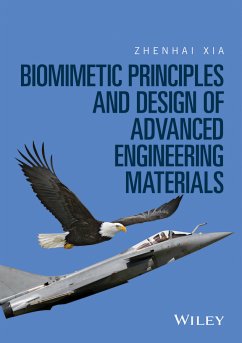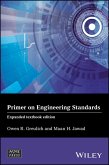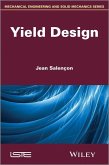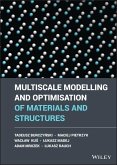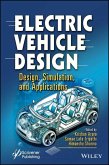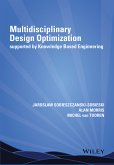Biomimetic Principles and Design of Advanced Engineering Materials (eBook, PDF)


Alle Infos zum eBook verschenken

Biomimetic Principles and Design of Advanced Engineering Materials (eBook, PDF)
- Format: PDF
- Merkliste
- Auf die Merkliste
- Bewerten Bewerten
- Teilen
- Produkt teilen
- Produkterinnerung
- Produkterinnerung

Hier können Sie sich einloggen

Bitte loggen Sie sich zunächst in Ihr Kundenkonto ein oder registrieren Sie sich bei bücher.de, um das eBook-Abo tolino select nutzen zu können.
This book explores the structure-property-process relationship of biomaterials from engineering and biomedical perspectives, and the potential of bio-inspired materials and their applications. A large variety of natural materials with outstanding physical and mechanical properties have appeared in the course of evolution. From a bio-inspired viewpoint, materials design requires a novel and highly cross disciplinary approach. Considerable benefits can be gained by providing an integrated approach using bio-inspiration with materials science and engineering. The book is divided into three parts;…mehr
- Geräte: PC
- mit Kopierschutz
- eBook Hilfe
- Größe: 31.61MB
![Primer on Engineering Standards, Expanded Textbook Edition (eBook, PDF) Primer on Engineering Standards, Expanded Textbook Edition (eBook, PDF)]() Maan H. JawadPrimer on Engineering Standards, Expanded Textbook Edition (eBook, PDF)40,99 €
Maan H. JawadPrimer on Engineering Standards, Expanded Textbook Edition (eBook, PDF)40,99 €![Yield Design (eBook, PDF) Yield Design (eBook, PDF)]() Jean SalenconYield Design (eBook, PDF)139,99 €
Jean SalenconYield Design (eBook, PDF)139,99 €![Multiscale Modelling and Optimisation of Materials and Structures (eBook, PDF) Multiscale Modelling and Optimisation of Materials and Structures (eBook, PDF)]() Tadeusz BurczynskiMultiscale Modelling and Optimisation of Materials and Structures (eBook, PDF)114,99 €
Tadeusz BurczynskiMultiscale Modelling and Optimisation of Materials and Structures (eBook, PDF)114,99 €![Electric Vehicle Design (eBook, PDF) Electric Vehicle Design (eBook, PDF)]() Electric Vehicle Design (eBook, PDF)168,99 €
Electric Vehicle Design (eBook, PDF)168,99 €![Multidisciplinary Design Optimization in Computational Mechanics (eBook, PDF) Multidisciplinary Design Optimization in Computational Mechanics (eBook, PDF)]() Multidisciplinary Design Optimization in Computational Mechanics (eBook, PDF)207,99 €
Multidisciplinary Design Optimization in Computational Mechanics (eBook, PDF)207,99 €![Mechanical Engineering Education (eBook, PDF) Mechanical Engineering Education (eBook, PDF)]() Mechanical Engineering Education (eBook, PDF)139,99 €
Mechanical Engineering Education (eBook, PDF)139,99 €![Multidisciplinary Design Optimization Supported by Knowledge Based Engineering (eBook, PDF) Multidisciplinary Design Optimization Supported by Knowledge Based Engineering (eBook, PDF)]() Jaroslaw Sobieszczanski-SobieskiMultidisciplinary Design Optimization Supported by Knowledge Based Engineering (eBook, PDF)98,99 €
Jaroslaw Sobieszczanski-SobieskiMultidisciplinary Design Optimization Supported by Knowledge Based Engineering (eBook, PDF)98,99 €-
-
-
Dieser Download kann aus rechtlichen Gründen nur mit Rechnungsadresse in A, B, BG, CY, CZ, D, DK, EW, E, FIN, F, GR, HR, H, IRL, I, LT, L, LR, M, NL, PL, P, R, S, SLO, SK ausgeliefert werden.
- Produktdetails
- Verlag: John Wiley & Sons
- Seitenzahl: 320
- Erscheinungstermin: 6. Juni 2016
- Englisch
- ISBN-13: 9781118926246
- Artikelnr.: 45253062
- Verlag: John Wiley & Sons
- Seitenzahl: 320
- Erscheinungstermin: 6. Juni 2016
- Englisch
- ISBN-13: 9781118926246
- Artikelnr.: 45253062
- Herstellerkennzeichnung Die Herstellerinformationen sind derzeit nicht verfügbar.
resistant and Impact
resistant Materials 49 3.1 Introduction 49 3.2 Hard Tissues with High Wear Resistance 50 3.2.1 Teeth: A Masterpiece of Biological Wear
resistance Materials 50 3.2.2 Microstructures of Enamel, Dentin, and Dentin
enamel Junction 51 3.2.3 Mechanical Properties of Dental Structures 54 3.2.4 Anti
wear Mechanisms of Enamel 56 3.2.5 Toughening Mechanisms of the DEJ 58 3.3 Biomimetic Designs and Processes of Materials for Wear
resistant Materials 59 3.3.1 Bioinspired Design Strategies for Wear
resistant Materials 59 3.3.2 Enamel
mimicking Wear
resistant Restorative Materials 61 3.3.3 Biomimetic Cutting Tools Based on the Sharpening Mechanism of Rat Teeth 62 3.3.4 DEJ
mimicking Functionally Graded Materials 64 3.4 Biological Composites with High Impact and Energy Absorbance 66 3.4.1 Mineral
based Biocomposites: Dactyl Club 67 3.4.2 Protein
based Biocomposites: Horns and Hooves 69 3.4.3 Bioinspired Design Strategies for Highly Impact
resistant Materials 72 3.5 Biomimetic Impact
resistant Materials and Processes 73 3.5.1 Dactyl Club-Biomimicking Highly Impact
resistant Composites 73 3.5.2 Damage
tolerant CNT
reinforced Nanocomposites Mimicking Hooves 74 References 76 4 Adaptive and Self
shaping Materials 79 4.1 Introduction 79 4.2 The Biological Models for Adapting and Morphing Materials 80 4.2.1 Reversible Stiffness Change of Sea Cucumber via Switchable Fiber Interactions 80 4.2.2 Gradient Stiffness of Squid Beak via Gradient Fiber Interactions 82 4.2.3 Shape Change in Plant Growth via Controlled Reinforcement Redistribution 84 4.2.4 Self
shaping by Pre
programed Reinforcement Architectures 86 4.2.5 Biomimetic Design Strategies for Morphing and Adapting 88 4.3 Biomimetic Synthetic Adaptive Materials and Processes 90 4.3.1 Adaptive Nanocomposites with Reversible Stiffness Change Capability 90 4.3.2 Squid
beak
inspired Mechanical Gradient Nanocomposites and Fabrication 93 4.3.3 Biomimetic Helical Fibers and Fabrication 94 4.3.4 Water
activated Self
shaping Materials and Fabrication 95 References 99 5 Materials with Controllable Friction and Reversible Adhesion 101 5.1 Introduction 101 5.2 Dry Adhesion: Biological Reversible Adhesive Systems Based on Fibrillar Structures 102 5.2.1 Gecko and Insect Adhesive Systems 102 5.2.2 Hierarchical Fibrillar Structure of Gecko Toe Pads 103 5.2.3 Adhesive Properties of Gecko Toe Pads 104 5.2.4 Mechanics of Fibrillar Adhesion 107 5.2.5 Bioinspired Strategies for Reversible Dry Adhesion 112 5.3 Gecko
mimicking Design of Fibrillar Dry Adhesives and Processes 112 5.3.1 Biomimetic Design Based on Geometric Replications of the Gecko Adhesive System 115 5.3.2 Biomimetic Design of Hybrid/Smart Fibrillar Adhesives 118 5.4 Wet Adhesion: Biological Reversible Adhesive Systems Based on Soft Film 121 5.4.1 Tree Frog Adhesive System 121 5.4.2 Adhesive Mechanism of Tree Frog Toe Pads 122 5.5 Artificial Adhesive Systems Inspired by Tree Frogs 123 5.6 Slippery Surfaces and Friction/Drag Reduction 125 5.6.1 Pitcher Plant: A Biological Model of a Slippery Surface 125 5.6.2 Shark Skin: A Biological Model for Drag Reduction 126 5.7 Biomimetic Designs and Processes of Slippery Surfaces 128 5.7.1 Pitcher
inspired Design of a Slippery Surface 128 5.7.2 Shark Skin
inspired Design for Drag Reduction 130 References 132 6 Self
healing Materials 135 6.1 Introduction 135 6.2 Wound Healing in Biological Systems 136 6.2.1 Self
healing via Microvascular Networks 136 6.2.2 Self
healing with Microencapsulation/Micropipe Systems in Plants 138 6.2.3 Skeleton/Bone Healing Mechanism 140 6.2.4 Tree Bark Healing Mechanism 141 6.2.5 Bioinspired Self
healing Strategies 142 6.3 Bioinspired Self
healing Materials 144 6.3.1 Self
healing Materials with Vascular Networks 144 6.3.2 Biomimetic Self
healing with Microencapsulation Systems 146 6.3.3 Biomimetic Self
healing with Hollow Fiber Systems 148 6.3.4 Self
healing Brittle Materials Mimicking Bone and Tree Bark Healing 149 6.3.5 Bacteriämediated Self
healing Concretes 151 References 152 Part II Biomimetic Functional Materials and Processing 155 7 Self
cleaning Materials and Surfaces 157 7.1 Introduction 157 7.2 Fundamentals of Wettability and Self
cleaning 158 7.3 Self
cleaning in Nature 160 7.3.1 Lotus Effect: Superhydrophobicity
induced Self
cleaning 160 7.3.2 Slippery Surfaces: Superhydrophilicity
induced Self
cleaning 162 7.3.3 Self
cleaning in Fibrillar Adhesive Systems 164 7.3.4 Self
cleaning in Soft Film Adhesive Systems 168 7.3.5 Underwater Organisms: Self
cleaning Surfaces 169 7.3.6 Biomimetic Strategies for Self
cleaning 171 7.4 Engineering Self
cleaning Materials and Processes via Bioinspiration 173 7.4.1 Lotus Effect-inspired Self
cleaning Surfaces and Fabrication 174 7.4.2 Superhydrophilically
based Self
cleaning Surfaces and Fabrication 178 7.4.3 Gecko
inspired Self
cleaning Dry Adhesives and Fabrication 180 7.4.4 Underwater Organisms-inspired Self
cleaning Surfaces and Fabrication 183 References 185 8 Stimuli
responsive Materials 188 8.1 Introduction 188 8.2 The Biological Models for Stimuli
responsive Materials 189 8.2.1 Actuation Mechanism in Muscles 189 8.2.2 Mechanically Stimulated Morphing Structures of Venus Flytraps 191 8.2.3 Sun Tracking: Heliotropic Plant Movements Induced by Photo Stimuli 194 8.2.4 Biomimetic Design Strategies for Stimuli
responsive Materials 196 8.3 Biomimetic Synthetic Stimuli
responsive Materials and Processes 198 8.3.1 Motor Molecules as Artificial Muscle: Bottom
up Approach 198 8.3.2 Electroactive Polymers as Artificial Muscle: Top
down Approach 199 8.3.3 Venus Flytrap Mimicking Nastic Materials 202 8.3.4 Biomimetic Light
tracking Materials 203 References 207 9 Photonic Materials 210 9.1 Introduction 210 9.2 Structural Colors in Nature 211 9.2.1 One
dimensional Diffraction Gratings 213 9.2.2 Multilayer Reflectors 214 9.2.3 Two
dimensional Photonic Materials 215 9.2.4 Three
dimensional Photonic Crystals 217 9.2.5 Tunable Structural Color in Organisms 218 9.3 Natural Antireflective Structures and Microlenses 220 9.3.1 Moth
eye Antireflective Structures 220 9.3.2 Brittlestar Microlens with Double
facet Lens 222 9.3.3 Biomimetic Strategies for Structural Colors and Antireflection 224 9.4 Bioinspired Structural Coloring Materials and Processes 224 9.4.1 Grating Nanostructures: Lamellar Ridge Arrays 227 9.4.2 Multilayer Photonic Nanostructures and Fabrication Approaches 229 9.4.3 Three
dimensional Photonic Crystals and Fabrication 230 9.4.4 Tunable Structural Colors of Bioinspired Photonic Materials 232 9.4.5 Electrically and Mechanically Tunable Opals 233 9.5 Bioinspired Antireflective Surfaces and Microlenses 233 References 236 10 Catalysts for Renewable Energy 240 10.1 Introduction 240 10.2 Catalysts for Energy Conversion in Biological Systems 242 10.2.1 Biological Catalysts in Biological "Fuel Cells" 242 10.2.2 Oxygen Evolution Catalyzed by Water
oxidizing Complex 242 10.2.3 Biological Hydrogen Production with Hydrogenase Enzymes 245 10.2.4 Natural Photosynthesis and Enzymes 245 10.2.5 Biomimetic Design Principles for Efficient Catalytic Materials 247 10.3 Bioinspired Catalytic Materials and Processes 248 10.3.1 Bioinspired Catalyst for Hydrogen Fuel Cells 249 10.3.2 WOC
biomimetic Catalysts for Oxygen Evalution Reactions in Water Splitting 255 10.3.3 Hydrogenase
biomimetic Catalysts for Hydrogen Generation 259 10.3.4 Artificial Photosynthesis 261 References 266 Part III Biomimetic Processing 271 11 Biomineralization and Biomimetic Materials Processing 273 11.1 Introduction 273 11.2 Materials Processing in Biological Systems 274 11.2.1 Biomineralization 274 11.2.2 Surface
directed Biomineralization 277 11.2.3 Enzymatic Biomineralization 278 11.2.4 Organic Matrix
templated Biomineralization 279 11.2.5 Homeostasis and Storage of Metallic Nanoparticles 282 11.2.6 Bioinspired Strategies for Synthesizing Processes 282 11.3 Biomimetic Materials Processes 284 11.3.1 Synthesis of Mineralized Collagen Fibrils with Macromolecular Templates 284 11.3.2 Synthesis of Nanoparticles and Films Catalyzed with Silicatein 286 11.3.3 Synthesis of Magnetite using Natural and Synthetic Proteins 288 11.3.4 Nanofabrication of Barium Titanate using Artificial Proteins 290 11.3.5 Protein
assisted Nanofabrication of Metal Nanoparticles 292 References 294 Index 298
resistant and Impact
resistant Materials 49 3.1 Introduction 49 3.2 Hard Tissues with High Wear Resistance 50 3.2.1 Teeth: A Masterpiece of Biological Wear
resistance Materials 50 3.2.2 Microstructures of Enamel, Dentin, and Dentin
enamel Junction 51 3.2.3 Mechanical Properties of Dental Structures 54 3.2.4 Anti
wear Mechanisms of Enamel 56 3.2.5 Toughening Mechanisms of the DEJ 58 3.3 Biomimetic Designs and Processes of Materials for Wear
resistant Materials 59 3.3.1 Bioinspired Design Strategies for Wear
resistant Materials 59 3.3.2 Enamel
mimicking Wear
resistant Restorative Materials 61 3.3.3 Biomimetic Cutting Tools Based on the Sharpening Mechanism of Rat Teeth 62 3.3.4 DEJ
mimicking Functionally Graded Materials 64 3.4 Biological Composites with High Impact and Energy Absorbance 66 3.4.1 Mineral
based Biocomposites: Dactyl Club 67 3.4.2 Protein
based Biocomposites: Horns and Hooves 69 3.4.3 Bioinspired Design Strategies for Highly Impact
resistant Materials 72 3.5 Biomimetic Impact
resistant Materials and Processes 73 3.5.1 Dactyl Club-Biomimicking Highly Impact
resistant Composites 73 3.5.2 Damage
tolerant CNT
reinforced Nanocomposites Mimicking Hooves 74 References 76 4 Adaptive and Self
shaping Materials 79 4.1 Introduction 79 4.2 The Biological Models for Adapting and Morphing Materials 80 4.2.1 Reversible Stiffness Change of Sea Cucumber via Switchable Fiber Interactions 80 4.2.2 Gradient Stiffness of Squid Beak via Gradient Fiber Interactions 82 4.2.3 Shape Change in Plant Growth via Controlled Reinforcement Redistribution 84 4.2.4 Self
shaping by Pre
programed Reinforcement Architectures 86 4.2.5 Biomimetic Design Strategies for Morphing and Adapting 88 4.3 Biomimetic Synthetic Adaptive Materials and Processes 90 4.3.1 Adaptive Nanocomposites with Reversible Stiffness Change Capability 90 4.3.2 Squid
beak
inspired Mechanical Gradient Nanocomposites and Fabrication 93 4.3.3 Biomimetic Helical Fibers and Fabrication 94 4.3.4 Water
activated Self
shaping Materials and Fabrication 95 References 99 5 Materials with Controllable Friction and Reversible Adhesion 101 5.1 Introduction 101 5.2 Dry Adhesion: Biological Reversible Adhesive Systems Based on Fibrillar Structures 102 5.2.1 Gecko and Insect Adhesive Systems 102 5.2.2 Hierarchical Fibrillar Structure of Gecko Toe Pads 103 5.2.3 Adhesive Properties of Gecko Toe Pads 104 5.2.4 Mechanics of Fibrillar Adhesion 107 5.2.5 Bioinspired Strategies for Reversible Dry Adhesion 112 5.3 Gecko
mimicking Design of Fibrillar Dry Adhesives and Processes 112 5.3.1 Biomimetic Design Based on Geometric Replications of the Gecko Adhesive System 115 5.3.2 Biomimetic Design of Hybrid/Smart Fibrillar Adhesives 118 5.4 Wet Adhesion: Biological Reversible Adhesive Systems Based on Soft Film 121 5.4.1 Tree Frog Adhesive System 121 5.4.2 Adhesive Mechanism of Tree Frog Toe Pads 122 5.5 Artificial Adhesive Systems Inspired by Tree Frogs 123 5.6 Slippery Surfaces and Friction/Drag Reduction 125 5.6.1 Pitcher Plant: A Biological Model of a Slippery Surface 125 5.6.2 Shark Skin: A Biological Model for Drag Reduction 126 5.7 Biomimetic Designs and Processes of Slippery Surfaces 128 5.7.1 Pitcher
inspired Design of a Slippery Surface 128 5.7.2 Shark Skin
inspired Design for Drag Reduction 130 References 132 6 Self
healing Materials 135 6.1 Introduction 135 6.2 Wound Healing in Biological Systems 136 6.2.1 Self
healing via Microvascular Networks 136 6.2.2 Self
healing with Microencapsulation/Micropipe Systems in Plants 138 6.2.3 Skeleton/Bone Healing Mechanism 140 6.2.4 Tree Bark Healing Mechanism 141 6.2.5 Bioinspired Self
healing Strategies 142 6.3 Bioinspired Self
healing Materials 144 6.3.1 Self
healing Materials with Vascular Networks 144 6.3.2 Biomimetic Self
healing with Microencapsulation Systems 146 6.3.3 Biomimetic Self
healing with Hollow Fiber Systems 148 6.3.4 Self
healing Brittle Materials Mimicking Bone and Tree Bark Healing 149 6.3.5 Bacteriämediated Self
healing Concretes 151 References 152 Part II Biomimetic Functional Materials and Processing 155 7 Self
cleaning Materials and Surfaces 157 7.1 Introduction 157 7.2 Fundamentals of Wettability and Self
cleaning 158 7.3 Self
cleaning in Nature 160 7.3.1 Lotus Effect: Superhydrophobicity
induced Self
cleaning 160 7.3.2 Slippery Surfaces: Superhydrophilicity
induced Self
cleaning 162 7.3.3 Self
cleaning in Fibrillar Adhesive Systems 164 7.3.4 Self
cleaning in Soft Film Adhesive Systems 168 7.3.5 Underwater Organisms: Self
cleaning Surfaces 169 7.3.6 Biomimetic Strategies for Self
cleaning 171 7.4 Engineering Self
cleaning Materials and Processes via Bioinspiration 173 7.4.1 Lotus Effect-inspired Self
cleaning Surfaces and Fabrication 174 7.4.2 Superhydrophilically
based Self
cleaning Surfaces and Fabrication 178 7.4.3 Gecko
inspired Self
cleaning Dry Adhesives and Fabrication 180 7.4.4 Underwater Organisms-inspired Self
cleaning Surfaces and Fabrication 183 References 185 8 Stimuli
responsive Materials 188 8.1 Introduction 188 8.2 The Biological Models for Stimuli
responsive Materials 189 8.2.1 Actuation Mechanism in Muscles 189 8.2.2 Mechanically Stimulated Morphing Structures of Venus Flytraps 191 8.2.3 Sun Tracking: Heliotropic Plant Movements Induced by Photo Stimuli 194 8.2.4 Biomimetic Design Strategies for Stimuli
responsive Materials 196 8.3 Biomimetic Synthetic Stimuli
responsive Materials and Processes 198 8.3.1 Motor Molecules as Artificial Muscle: Bottom
up Approach 198 8.3.2 Electroactive Polymers as Artificial Muscle: Top
down Approach 199 8.3.3 Venus Flytrap Mimicking Nastic Materials 202 8.3.4 Biomimetic Light
tracking Materials 203 References 207 9 Photonic Materials 210 9.1 Introduction 210 9.2 Structural Colors in Nature 211 9.2.1 One
dimensional Diffraction Gratings 213 9.2.2 Multilayer Reflectors 214 9.2.3 Two
dimensional Photonic Materials 215 9.2.4 Three
dimensional Photonic Crystals 217 9.2.5 Tunable Structural Color in Organisms 218 9.3 Natural Antireflective Structures and Microlenses 220 9.3.1 Moth
eye Antireflective Structures 220 9.3.2 Brittlestar Microlens with Double
facet Lens 222 9.3.3 Biomimetic Strategies for Structural Colors and Antireflection 224 9.4 Bioinspired Structural Coloring Materials and Processes 224 9.4.1 Grating Nanostructures: Lamellar Ridge Arrays 227 9.4.2 Multilayer Photonic Nanostructures and Fabrication Approaches 229 9.4.3 Three
dimensional Photonic Crystals and Fabrication 230 9.4.4 Tunable Structural Colors of Bioinspired Photonic Materials 232 9.4.5 Electrically and Mechanically Tunable Opals 233 9.5 Bioinspired Antireflective Surfaces and Microlenses 233 References 236 10 Catalysts for Renewable Energy 240 10.1 Introduction 240 10.2 Catalysts for Energy Conversion in Biological Systems 242 10.2.1 Biological Catalysts in Biological "Fuel Cells" 242 10.2.2 Oxygen Evolution Catalyzed by Water
oxidizing Complex 242 10.2.3 Biological Hydrogen Production with Hydrogenase Enzymes 245 10.2.4 Natural Photosynthesis and Enzymes 245 10.2.5 Biomimetic Design Principles for Efficient Catalytic Materials 247 10.3 Bioinspired Catalytic Materials and Processes 248 10.3.1 Bioinspired Catalyst for Hydrogen Fuel Cells 249 10.3.2 WOC
biomimetic Catalysts for Oxygen Evalution Reactions in Water Splitting 255 10.3.3 Hydrogenase
biomimetic Catalysts for Hydrogen Generation 259 10.3.4 Artificial Photosynthesis 261 References 266 Part III Biomimetic Processing 271 11 Biomineralization and Biomimetic Materials Processing 273 11.1 Introduction 273 11.2 Materials Processing in Biological Systems 274 11.2.1 Biomineralization 274 11.2.2 Surface
directed Biomineralization 277 11.2.3 Enzymatic Biomineralization 278 11.2.4 Organic Matrix
templated Biomineralization 279 11.2.5 Homeostasis and Storage of Metallic Nanoparticles 282 11.2.6 Bioinspired Strategies for Synthesizing Processes 282 11.3 Biomimetic Materials Processes 284 11.3.1 Synthesis of Mineralized Collagen Fibrils with Macromolecular Templates 284 11.3.2 Synthesis of Nanoparticles and Films Catalyzed with Silicatein 286 11.3.3 Synthesis of Magnetite using Natural and Synthetic Proteins 288 11.3.4 Nanofabrication of Barium Titanate using Artificial Proteins 290 11.3.5 Protein
assisted Nanofabrication of Metal Nanoparticles 292 References 294 Index 298
